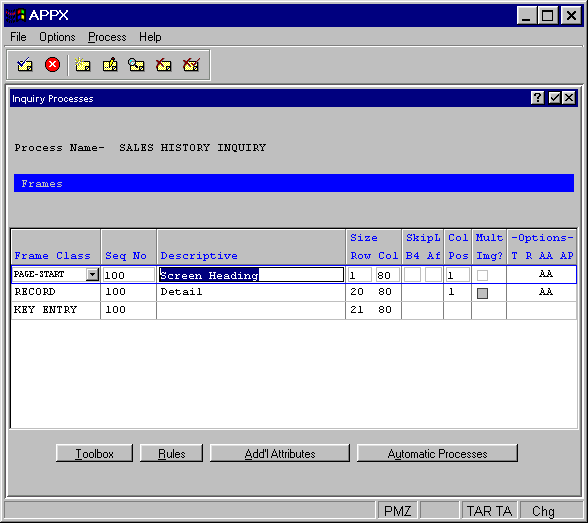


Chapter 3-10: Inquiry Processes



Inquiry Frame Specifications
Inquiry frame specifications define attributes and statements unique to frames that manipulate the keys
from each record in a PCF. The inquiry frames overlay, shown in Figure 3-10-5, is automatically
generated after you select enter ![]() from the Inquiry Processes screen.
from the Inquiry Processes screen.

Figure 3-10-5. Inquiry Frames Overlay
The inquiry process Frames overlay contains the following fields.
· Frame Class defines the type of frame with which you are working. Valid options are:
Report-Start frames print once at the beginning of a report. APPX executes a page break immediately after the last Report-Start frame prints.
Page-Start frames print once at the beginning of each page of a report. They are primarily used for page headings and column headings. Standard images for both of these are optionally available. Refer to Standard Column Heading Image for additional information.
Range-Start frames print immediately before the first record for which the value in a specific sort field (the range field) changes. They are primarily used for subheadings and lower-level column headings. Standard images for both of these are optionally available. Refer to Standard Column Heading Image for additional information.
Record frames manipulate and print information read from the process control file. They comprise the body of a report. Record frames can be defined to scroll.
Range-End frames print immediately after the last record in a series of records that have the same value in a specific sort field (the range field). They are primarily used for subtotals, and a standard subtotal image is optionally available.
Page-End frames print once at the conclusion of each page of a report.
Report-End frames print once at the conclusion of a report. APPX executes a page break immediately before the first Report-End frame executes.
Key-Entry frames manipulate the keys from each record in a PCF.
· Seq No displays a sequence number that is defaulted by APPX and used to identify the frame. This default sequence number can be overridden, but must be unique within the frame class for the process. Sequence numbers determine the order of the frames in the process structure and may contain up to seven numeric characters. The first frame that is defined in add mode is assigned sequence number 100, and additional frames are assigned a number equal to the highest existing sequence number, plus 100.
· Descriptive identifies this frame. The description is used for documentation purposes only.
· Size—Row/Col designates the number of rows and columns that compose the frame. The default is 21, 80.
· SkipL B4, displayed for all Inquiry frame classes except Key Entry, indicates the number of blank lines to be printed before executing this frame. The default is 0.
· SkipL Af, displayed for all Inquiry frame classes except Key Entry, indicates the number of blank lines to print subsequent to executing this frame. The default is 0.
· Col Pos designates how many columns over from the left side of the image that the report will print. See Frame/Image Positioning in Chapter 3-2 for more information.
·
Mult Img? This field indicates that this output frame contains more than one image if checked
“yes” ![]() .
If “no”
.
If “no” ![]() is entered, you will be unable to add more than one entry at the image level. The default is “no”.
is entered, you will be unable to add more than one entry at the image level. The default is “no”.
· Options are indicators that are present whenever documentation (T), rules (R), additional attributes (AA), or automatic processes (AP) have been defined for this process.
The following options as described in the corresponding sections are available on the inquiry Frames overlay:
· Toolbox
· Rules
APPX Application
Design Manual (01/13/03)



© 2003 by APPX Software, Inc. All rights reserved